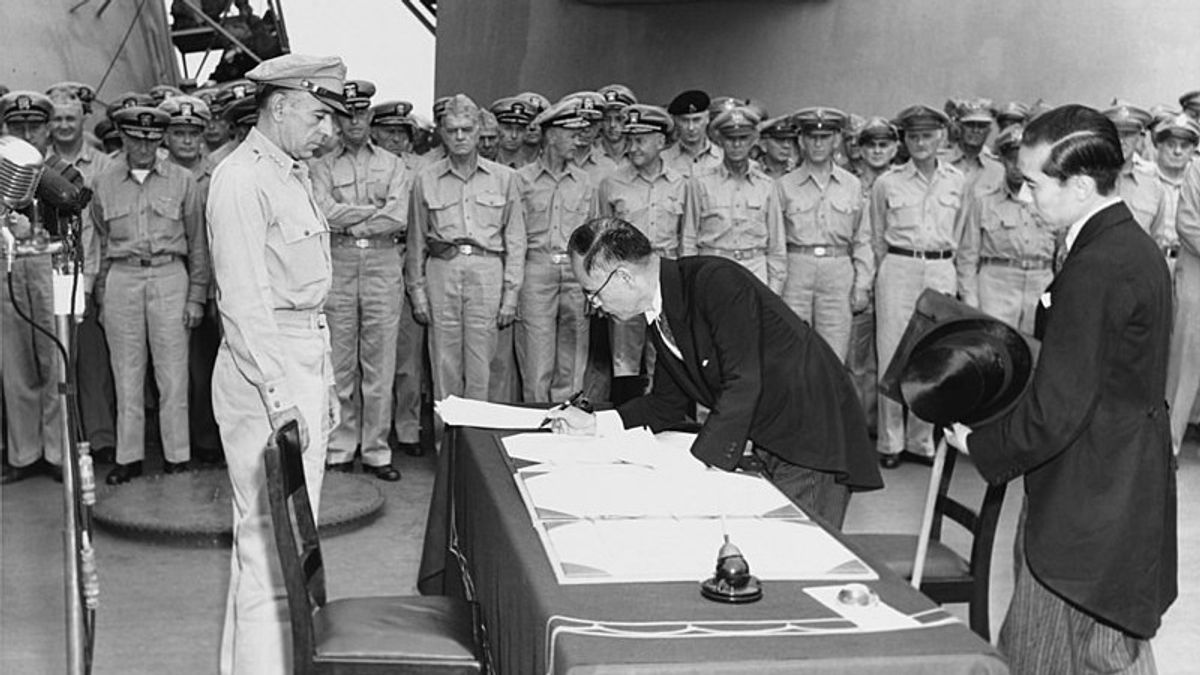JAKARTA - At exactly 9 am today, September 2, 1945, Japanese Foreign Minister Mamoru Shigemitsu signed a statement to the allies on behalf of his country. The tears of his assistants who also witnessed could not be stopped. Japan surrendered. This is also the moment the end of World War II.
The moment came after more than 250 Allied warships docked in Tokyo Bay. The flags of the United States (US), Britain, the Soviet Union, and China fly above the deck of the Missouri Ship.
According to History, US Commander-in-Chief Douglas MacArthur subsequently signed a statement stating, "It is my sincere hope and certainly the hope of all humanity that from this solemn occasion a better world will emerge from the blood and slaughter of the past."
Nine more signatures were inked, one each by the US, China, UK, Soviet Union, Australia, Canada, France, the Netherlands and New Zealand. As the 20-minute ceremony ended, the sun broke through the low-hanging clouds. The most devastating war in human history has ended.
Japan's defeat was a foregone conclusion. Previously the Japanese Navy and Air Force had been destroyed. The Allied naval blockade of Japan and the intensive bombing of Japanese cities had devastated the country and its economy.
In late June 1945, the US captured Okinawa, an island in Japan. The struggle allowed the Allies to launch an invasion of Japan's main islands. General MacArthur was tasked with carrying out the invasion, codenamed "Olympic Operation" and planned for launch in November 1945.

After the atomic bombing on Hiroshima, a faction of Japan's supreme war council supported the acceptance of the Potsdam Declaration, but the majority of the council rejected unconditional surrender. On August 8, Japan's desperate situation worsened again when the Soviet Union declared war on Japan. The next day, Soviet troops invaded Manchuria and a second US atomic bomb was dropped on Nagasaki.
The Imperial Council of Japan at that time simply had a stalemate. Finally the Japanese Emperor Hirohito decided that his country should surrender. At noon on August 15, 1945, the emperor announced the surrender of Japan in his first radio broadcast.
Before Japan surrendered, fellow Axis countries, namely Germany, also raised a white flag. After the bombing of Dresden and other German cities that killed tens of thousands of civilians, the Allies crossed the Rhine River and moved east toward Berlin. As they approached the capital, Allied forces discovered the horrors of the Holocaust and liberated concentration camps such as Bergen-Belsen and Dachau. With both fronts torn down and defeat inevitable, Hitler committed suicide in his bunker on April 30, 1945.
Nazi's TurnHitler's successor, Karl Dönitz, began peace negotiations and on 7 May 1945 authorized General Alfred Jodl to sign the unconditional surrender of all German troops effective the following day. But the leader of the Soviet Union, Joseph Stalin, refused to accept the treaty signed at the headquarters of US General Dwight D. Eisenhower in Reims, France. He forced Germany to sign another treaty the following day in Soviet-occupied Berlin.

World War II was one of the great turning points of twentieth century geopolitical history. This resulted in the expansion of the Soviet Union's power to Eastern European countries, allowed the communist movement to gain power in China, and marked a decisive shift of power in the world away from Western European countries and towards the US and the Soviet Union.
According to the Britannica report, World War II casualty statistics were never accurate. Only the US and the British Commonwealth can provide official figures showing the dead, injured, prisoners or missing from the armed forces. For most other countries, there are only estimates with varying reliability.
Unclear statistical calculations in Allied and Axis countries when entire armies surrender or disband. Guerrilla warfare, changing international boundaries, and mass movements in populations greatly complicated postwar efforts to reach even accurate figures for the death toll from all causes.
For this reason, estimates of the death toll in World War II vary from 35,000,000 to 60,000,000. Few dared to try to calculate the total number of people who were injured or permanently disabled.
*Read other information about TODAY's HISTORY or read other interesting articles from Putri Ainur Islam.
TODAY'S HISTORY More
The English, Chinese, Japanese, Arabic, and French versions are automatically generated by the AI. So there may still be inaccuracies in translating, please always see Indonesian as our main language. (system supported by DigitalSiber.id)









